Hearing loss is a struggle for millions of people.
The best way to improve your hearing loss is with a hearing aid.
In the past, hearing aids were bulky and cumbersome to use, but modern hearing aids can be bought over the counter and online that are low profile, effective, and inexpensive. Our research team compared all of the best hearing aids on the market and came up with these rankings.
1. Otofonix hearing aid
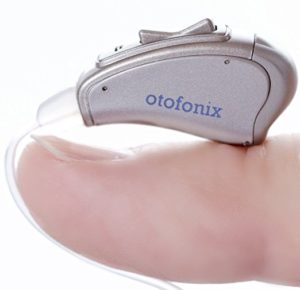
Click here for the lowest price on Amazon
For the absolute best in technology you can get over the counter, it’s hard to argue with Otofonix. Yes, it’s a behind the ear design, but it’s an ultra-slim design that has the latest sound processing technology to help augment your hearing.
Adjusting the volume is trivial, and the sound transmission tube is so small it’s easily concealed. As an added perk, this hearing aid comes with free lifetime tech support from Otofonix, so you don’t have to worry about malfunctions.
2. Empower Hearing Aid
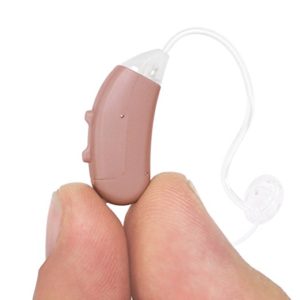
Click here for the lowest price on Amazon
Though behind the ear designs are often criticized for their bulk and inconvenience, the Empower hearing aid manages to buck this trend.
The ultra-slim design fits snugly behind your ear, with only a translucent rubberized tube running into your ear to transmit the amplified sound.
With excellent reviews for its secure fit, battery life, and sound quality, this is a winner when it comes to the behind the ear design.
3. Easyuslife Hearing Aid
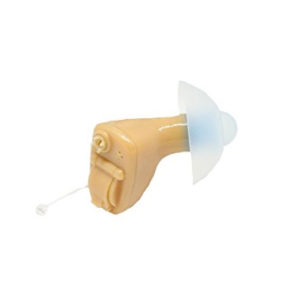
Click here for the lowest price on Amazon
When you need a super low-profile hearing aid, Easyuslife is the way to go. With an in-canal design, this hearing aid doesn’t rely on the bulk behind the ear compartments that many other competitors demand to house all of the electronics.
Of course, such a compact design does have drawbacks: namely, the battery life is not as good. But when it comes to being discrete, this hearing aid is a winner.
4. Sentire Med SM-220
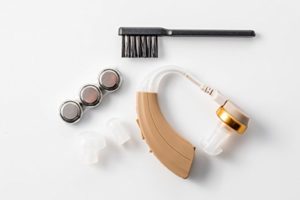
Click here for the lowest price on Amazon
The Sentire Med SM-220 is behind-the-ear hearing aid model that boast a wide range of customizable functions for optimal usability.
It has four frequency modes for different settings, and a good battery life. It’s low profile for behind-the-ear models, but it certainly isn’t discrete. You’ll have to look elsewhere for a truly low-profile hearing aid.
5. NewEar Hearing Aid
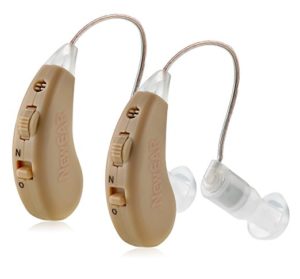
Click here for the lowest price on Amazon
NewEar offers an ingenious solution to the irritating problem of hearing aid batteries–their hearing aid is rechargable in a dock that plugs into any standard USB plug.
This makes charging and storage incredibly easy. However, the sound quality is not the best; some users complain about crackling and distorted sound.
6. Woodland Whisper
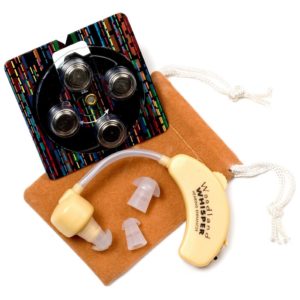
Click here for the lowest price on Amazon
Woodland Whisper is a hearing aid that was specifically designed for long-range, soft sounds. It’s beloved especially by hunters and archers, hence the name.
But you don’t need to be out in the forest to gain the benefit of the Woodland Whisper hearing aid. Any situation where you need to be able to hear far-off sounds more clearly is a great situation for this hearing aid.
7. Vorfreude In-The-Canal
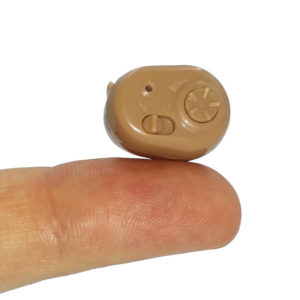
Click here for the lowest price on Amazon
Vorfreude makes a very solid in-canal design that fits snugly into your ear. It’s not the smallest or most discreet hearing aid, even among the in-canal designs. Instead, where this hearing aid shines is in its sound quality and secure fit.
8. HearingAssist Air Conduction
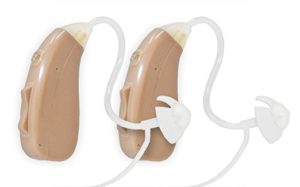
Click here for the lowest price on Amazon
HearingAssist provides a decent behind the ear model whose prime selling points are that it comes in a matching set of two–great if you have hearing loss on both sides–and that it keeps the speaker unit inside the behind-the-ear component.
The in-ear part is just a flexible rubber piece which conducts the sound into your ear, which enables a better fit. An additional perk is its rechargeable dock, and the ability to go up to 20 hours of use on a single charge.
9. MEDca Behind the Ear
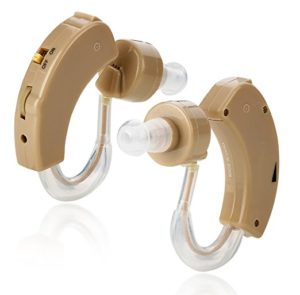
Click here for the lowest price on Amazon
MEDca offers a pretty basic behind-the-ear design that amplifies sound and transmit it to an earbud. It’s pretty large and bulky, so it’s not very discrete, and reviews are mixed when it comes to the sound quality and amplification level.
10. NewEar In-The-Canal

Click here for the lowest price on Amazon
NewEar has a behind the ear and an in the canal model of its hearing aids, but generally this company seems to perform better with the over the ear type.
Users of the NewEar in-canal design don’t like the fit, and they find that the battery life leaves something to be desired. There are better designs out there when it comes to the in the canal design of hearing aids.
Hearing aid benefits and side effects
When you have hearing loss, it can be alarming how much of your life you miss out on. A hearing aid is a quick and easy fix to get around the negative effects of hearing loss.
Happily, you don’t even need a doctor’s order to get a hearing aid, as many high-quality designs are now available over the counter.
Benefits
The prevalence of hearing loss is staggering. According to a 2011 study published in the Journal of the American Medical Association, fully 30 million Americans have some degree of hearing loss–this represents almost 13% of the population aged 12 and older (1).
Worse, the prevalence increase substantially when you consider the number of people who have “unilateral” hearing loss, which is hearing loss on only one side. When considering one-sided hearing loss, the prevalence climbs to 48 million people. That’s one in five people in the general population.
Hearing loss tends to affect men more commonly than women, and the prevalence goes up as your age gets older. Just like elderly people deal with loss of vision, loss of testosterone levels, loss of muscle mass, two thirds of adults will deal with the loss of hearing.
One troubling finding is that many people with mild to moderate hearing loss don’t use hearing aids to compensate for their hearing loss.
A study published in the Journal of Gerontology in 2011 found that only 40% of people with moderate hearing loss used hearing aids, and a measly 4% of people with mild hearing loss used hearing aids (2).
While the inconvenience of using a hearing aid might justify not using a hearing aid in mild cases of hearing loss, the fact that over half of people with moderate hearing loss don’t use hearing aids is a point of concern, especially because the effects of hearing loss are more insidious than just missing out on some auditory events in life.
There is emerging evidence that hearing loss is associated with increased risk for dementia. This was first reported by researchers at the Johns Hopkins School of Medicine, who conducted a study on over 600 people who underwent screening for hearing loss during the 1990s (3).
The subjects were followed over the next twelve years, and the researchers conducting the study documented the incidence of dementia in the cohort of people. They found that hearing loss was a significant risk factor for dementia, and moreover, the greater the degree of hearing loss, the greater the risk of dementia.
Those with mild hearing loss were only about 1.9 times as likely to develop dementia compared to those who had no hearing loss, but moderate hearing loss conferred a 3-fold increase in risk, and those with severe hearing loss were nearly five times as likely to develop dementia.
These findings were significant even after controlling for potentially confounding factors, like gender and age at time of screening.
The authors discuss the possible implications of this finding in depth. There are two potential explanations; the first is that some unknown factor–perhaps a genetic trait–causes both hearing loss and cognitive decline.
But another plausible explanation is that the hearing loss is actually causally related to cognitive decline–i.e. Losing your hearing actually leads to mental decline. This could be because missing out on sounds, voices, and conversations results in less cognitive stimulation of your brain.
If this is the case, wearing a hearing aid could potentially negate this effect, since it would allow you to engage your brain with the auditory world again.
While there needs to be more research on this finding, since these results were reported less than ten years ago, the causal link is at least plausible, and since there are few downsides to wearing a hearing aid, it’s worth recommending to people with hearing loss.
So, how should you select a hearing aid if you have hearing loss? Broadly speaking, hearing aids come in two styles. The first and more common variety is the behind the ear model.
This is probably what comes to mind when you think of a hearing aid: a rectangular box that sits behind the ear, powered by a battery that amplifies sound and sends it into your ear canal via a speaker.
The benefits of this design include longer battery life, better sound amplification, and often (though not always), better sound quality. The larger volume of the behind the ear box allows for electronic components and larger batteries that wouldn’t fit in a low-profile design.
The drawbacks are pretty obvious: they can be pretty large, and they’re hanging off your ear for the whole world to see. If your skin tone doesn’t match the standard tan that’s used by most companies, it will be even more obvious you are wearing a hearing aid.
The bulky design is less of a problem in the lastest design; some of the top behind the ear models now are no larger than a pencil eraser. If you have medium to long hair, you can effectively hide it behind your ear and hairline.
Many of the top behind the ear hearing aids have taken the innovative step of putting the speaker inside the behind the ear unit, and using a hollow tube to conduct the amplified sound into the hearing canal. Older models used to run a metal wire from the box to a speaker that sat in the ear.
The other style of hearing aid is the in the canal design. As the name suggests, this hearing aid sits inside your ear canal, held in snugly by a silicone rubber flange much like an earbud.
The only difference is that there’s no wire coming out–the unit is totally self-contained. For a totally discrete look, it’s impossible to beat the in the canal hearing aid design.
The downsides are primarily related to the size. Because the design parameters put a high premium on being low profile, the battery life in these hearing aids tends to be worse than in a behind the ear design.
Since there’s less room for electronic components like amplifiers, microphones, and sound processing technology, the amplification and sound quality may not be as good. One advantage in the sound quality department is that the speaker sits directly in the canal, instead of in the behind the ear unit.
Side Effects
Hearing aids can have negative effects when used improperly. If they aren’t cleaned regularly, the skin around the hearing aid can get irritated or even infected, and if the hearing aid is used at an improperly loud setting, you could actually worsen your hearing loss by exposing yourself to sounds that are too loud.
This is why a high-quality hearing aid with a proper method of adjusting the volume is very important when selecting a hearing aid.
Recap
If you have hearing loss, you don’t have to be relegated to a second-rate quality of life. With hearing aid technology rapidly advancing and miniaturizing, you can get a hearing aid over the counter that’s got good sound quality, high amplification, long battery life, and a low-profile fit.
Choosing the right hearing aid is a matter of deciding on whether the behind the ear or the in the canal design works best for your intended use, then selecting the right model.
There are advantages and disadvantages to both design styles, but regardless of which you choose, a high-quality hearing aid will help avoid the frustration and embarrassment that can come along with trying to live with hearing loss.
https://bodynutrition.org/hearing-aids/
No comments:
Post a Comment